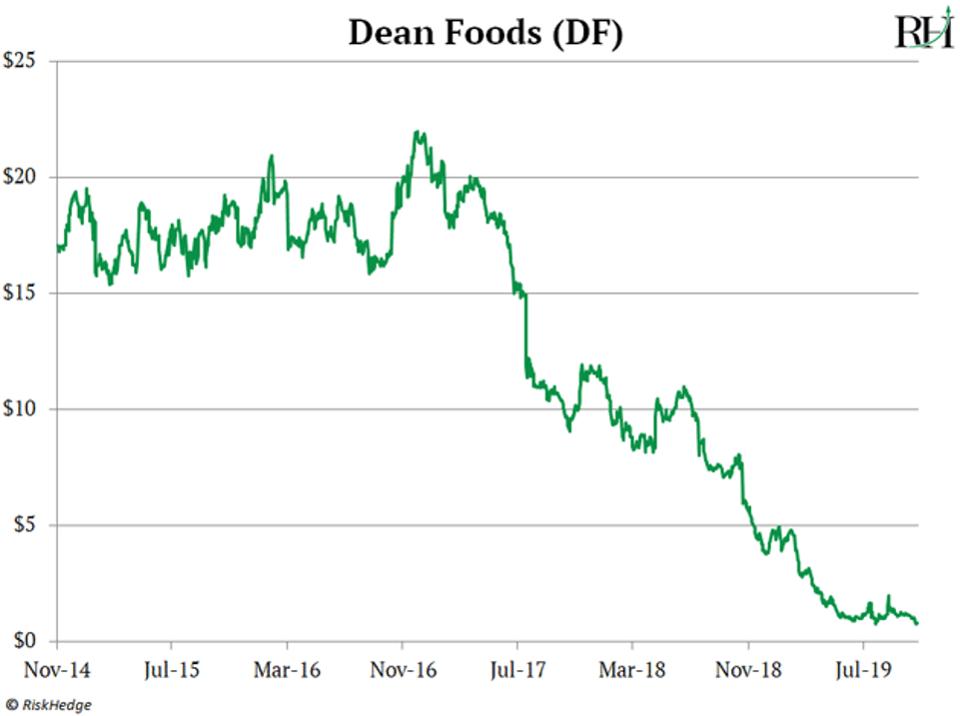
Sam’s company, Dean Foods (DF), cashed in on the heyday of milk. It grew and grew and grew, eventually becoming the largest milk producer in the US. But last week, after 93 years in business, Dean Foods went bankrupt.
Today Milk Is a Tough Business
Remember when “milk” meant regular, good ol’ cow’s milk? At the grocery store you’d see whole milk, 2%, skim, and that was pretty much it. Now you can choose almond milk, coconut milk, lactose-free milk, soy milk, rice milk, even oat milk.
Starbucks (SBUX) recently started offering almond milk, saying “it was one of the most requested customer suggestions of all time.” The shelves are packed with exotic sounding brands like Almond Breeze and Silk.
Meanwhile cow’s milk sales have tumbled for 10 years in a row. In fact, Americans drink almost 40% less real milk today than in 1970. Many folks still pour a drop in their coffee. But who has a big glass of milk with dinner anymore?
The Real Executioner of Dean Foods
Although the long, slow decline of milk contributed to Dean Foods’ bankruptcy, the business was really handed its death warrant last year. Walmart (WMT) was the executioner.
For years Walmart was Dean Foods’ largest customer, buying roughly 20% of its milk. Walmart bought 125 million gallons of milk from Dean in 2017! But last year things changed. Walmart decided to build its own milk plant in Indiana. It cut all ties with Dean Foods in 2018.

Walmart Is One of the Most Disruptive Forces in America
Walmart is the largest grocery chain in America. It has over 5,300 stores across the country. And it’ll sell over $300 billion worth of groceries this year.
Walmart probably doesn’t come to mind when you think “disruption.” But behind the scenes, Walmart is quietly dominating one of the most important disruptive changes in the US today: the rise of online groceries. As I mentioned a few months back, Americans spend more money on food than anything besides housing.
Yet how we buy groceries has barely changed in the last 60 years. Most of us still drive to the grocery store once or twice a week. We still push a cart up and down the aisles. We still place our items on a conveyor belt at the register. In fact, only 3% of groceries are bought online today.
Walmart Has Finally Cracked the Code on Grocery Delivery
For years, all attempts to disrupt groceries have failed. Why? Because food goes bad. You can throw a book in a brown cardboard box, chuck it in the back of a van, and have the delivery guy drop it on your porch two days later.
As I’ve explained, that doesn’t work for perishables like bananas or milk. Walmart is using its sprawling network of stores as “mini-warehouses” from which fresh groceries can be delivered quickly, without travelling far.
It recently rolled out its “Delivery Unlimited” membership in 1,500 stores. For 98 bucks/year you get unlimited same-day grocery delivery. You order your weekly groceries on Walmart.com in the morning… and they arrive at your front door in the afternoon.
Walmart Will Deliver Groceries to Your Fridge
Walmart is pushing the envelope even further. It’s testing a program where it delivers the groceries right into your fridge! In short, you fit your door with a special lock. When you order online, Walmart creates a one-time code for your door.
The Walmart delivery guy then uses the code to unlock the door. He wears a camera on his chest so you can watch him place the food in your fridge. The company is testing it in three markets right now, with plans to roll it out nationwide soon.
Walmart Is Turning the Grocery Market on Its Head
There are a few key signs I look for in a viable disruption. The #1 thing is rapid growth. Walmart’s online sales have grown at an average clip of 40% for 12 quarters straight. My calculations show Walmart’s online sales should hit roughly $30 billion this year.
On the latest earnings call, CEO Doug McMillon said groceries are the driving force behind the company’s rapidly growing online business. Walmart is already the largest player in America’s $1.5 trillion grocery market. Its big push into grocery delivery will help it grab an even bigger chunk of the market.
Think about it, Walmart’s “thing” was offering everyday low prices. We all know we can save money shopping at Walmart. But it’s not always convenient to drive across town and shop there. Now, Walmart will deliver groceries at everyday low prices to your front door…and soon right into your fridge. What’s not to like?
Here’s the thing, Walmart has a store within 90% of US households. This sprawling footprint gives Walmart the ability to deliver fresh groceries to millions of Americans every day.
Keep in mind, Walmart has only launched online delivery in less than one-third of its stores so far. As it rolls it out nationwide, the 40% growth in its online business could easily double.
I’ve owned Walmart stock for a while. It’s shot up 30% this year, and I expect it to climb much higher in the next few years.























